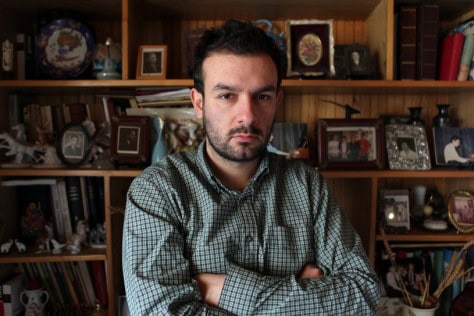Sammy Harkham is proof that the line between fine art and comics has disappeared. His series Crickets, along with the anthology he edits, Kramers Ergot, are prime examples of what the medium is capable of. They are beautifully drawn, well-crafted stories which are much more than disposable entertainment.
Comics are not a vehicle to more respectable pursuits for the Los Angeles based cartoonist. Sure he could reach more people or make more money through other mediums, but comics are what Harkham loves.
“You can intellectually know what you should be doing, but you end up doing what you are compelled to do,” said Harkham.
Comics have been a lifelong interest for the 28-year-old, something which proved to be problematic when he and the rest of his family moved to Australia in 1993. “He was a huge comic nerd when I met him and really alone because he couldn't find anyone else,” said David Kramer, Harkham's best friend.
Despite finding no one to share his love of comics with, Harkham kept reading and drawing them. He also found other outlets for his artistic talents, drawing posters for shows and local Australian bands.
However, Harkham did not really start putting out his own comics until he moved back to Los Angeles at age 17. Along with some mini comics he also produced a ‘zine he called Kramers Ergot, named in part because he and Kramer had repeatedly failed to put out a ‘zine of their own while he was in Australia.
Over the next few years Harkham kept working on his comics, finally garnering attention for the strip “Poor Sailor.” The story about the consequences of a life at sea was one of the centerpieces of Kramers Ergot 4 (which had by then grown from a ‘zine into a book-sized anthology) and would be reprinted in the Dave Eggers-edited Best American Non Required Reading of 2004 and published in book form by Drawn & Quarterly Press the next year.
Besides the inclusion of “Poor Sailor,” Kramers Ergot 4 was of a completely different scale than previous issues, both in terms of physical size and content . The jumbo-sized book was also the first to truly reflect its editor's sensibilities and people took notice.
“The first big issue of Kramers, was like okay, I'm glad I'm on this ride,” said musician Will Oldham, a.k.a. Bonnie “Prince” Billy, over the phone. As Harkahm’s friend and something of a mentor, Oldham had been able to watch the cartoonist develop as an artist, to the point where he felt comfortable asking him to illustrate the lyric book for his 1999 album, I See Darkness.
It is a view that Harkham himself shares. “I think I was just a lot more comfortable,” he said. “No more posing, no more doing things because that's the way things are supposed to be done. With Kramers 4, I just made a book that was 100 per cent unselfconscious. This was something I wanted to read, something I wanted to do. It just felt right.”
The fourth issue would make Kramers Ergot and its editor key figures in the art comics scene. “If features unique work,” said Dan Nadel, publisher of Picturebox Inc., over the phone. “It's stuff that won't appear anywhere else.”
In a field where anthologies are common place, one of the things which has most set Kramer’s apart is Harkham's editing. He has proven to have an eye for talented young cartoonists. “He's bringing young and new cartoonists to a wider audience,” says Alvin Buenaventura, publisher of issues six and seven of Kramers Ergot. “Early in a cartoonist’s career he's able to tell if there's something there.”
Harkham's editing techniques are not very complicated―he showcases work that excites him, comics that show the author's world view. But he also takes the cohesiveness of the book into account. “With Kramers I'm trying to make something that the whole has is better than its parts,” he said.
Critical regard for Kramers Ergot should only increase with the seventh issue. Although only 96 pages long, the book measures a staggering 21″ x 16,” similar in size to the newspaper strips from the early 20th century. The decision to make such a large book was influenced by the Masters of American Comics exhibit at the Armand Hammer Museum of Art and Culture Center that ran from late November 2005 until March 2006. Harkham said he was intrigued by the idea of giving some of his favorite cartoonists a chance to work at a bigger size, to play around with things in a manner never before available to them.
The book features names familiar to anyone who has browsed the graphic novel section of their local bookstores, names like Dan Clowes, Adrian Tomine, and Chris Ware, along with some lesser known artists like Shary Boyle, Chris Forgues, and Kevin Huizenga, who are pushing the medium even further.
Although Kramers has taken up much of his time during 2008, Harkham is still working on his own more personal projects like his comic series, Crickets. “My goal is to make Crickets the best comic that ever existed,” Harkham said.
Unlike many of his peers, Harkham's work is not autobiographical. He allows his life experiences to influence his storytelling, but all of his work has featured fictional characters in fully developed worlds. His stories are drawn in a cartoonish style that gives his characters an energy that really leaps off the page.
Although still young, Harkham has accomplished a lot for a cartoonist. Because of this success, it is easy to wonder if he will move on from comics. But while he has dabbled in some other fields—including illustrating the cover for the Penguin Classics Deluxe edition of Frank Kafka's Metamorphosis and Other Stories and co-owning Family, a curated bookstore in Los Angeles—Harkham still sees a future for himself in comics.
A big reason for this is that comics offers him more freedom than other mediums. It may not have the cache of other painting or directing, but cartooning gives Harkham the chance to practice drawing, writing, design, and typography, rather than focusing on just one. “Comics incorporate everything that I'm interested in,” said Harkham.
It's also clear that Harkham still feels he has a way to go as a cartoonist. “There are the comics you want to the make and then the comics you do make,” he says. But each new project provides another opportunity to rely on past experiences and improve, an idea which he is dedicated to.
“He's serious,” Buenaventura said. “A lot of artists may produce one or two things then disappear, but Sammy is always pushing himself, never satisfied with what he has done.”
Despite the attention that comics have received lately, Harkham realizes that his audience is still limited. But he says that comics give him the chance to produce work that best represents who he is and if he can reach people in the process that is an added bonus. “You just do the work you need to do and hope that people like it,” he said.
“You speak to who you can. To affect one person is awesome.”
An abridged version of this article appears in Anthem Issue 37, Winter 2008.
 Q&A with Larry Gus
Q&A with Larry Gus We Own the Night: The Edison
We Own the Night: The Edison
No Comments